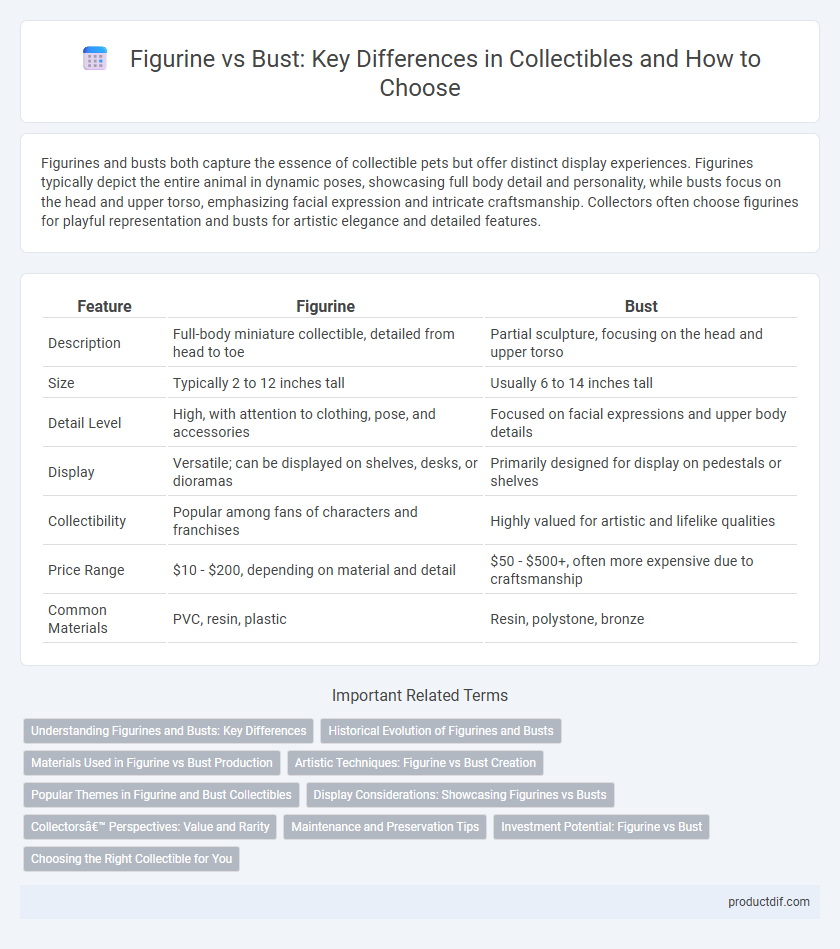Figurines and busts both capture the essence of collectible pets but offer distinct display experiences. Figurines typically depict the entire animal in dynamic poses, showcasing full body detail and personality, while busts focus on the head and upper torso, emphasizing facial expression and intricate craftsmanship. Collectors often choose figurines for playful representation and busts for artistic elegance and detailed features.
Table of Comparison
| Feature | Figurine | Bust |
|---|---|---|
| Description | Full-body miniature collectible, detailed from head to toe | Partial sculpture, focusing on the head and upper torso |
| Size | Typically 2 to 12 inches tall | Usually 6 to 14 inches tall |
| Detail Level | High, with attention to clothing, pose, and accessories | Focused on facial expressions and upper body details |
| Display | Versatile; can be displayed on shelves, desks, or dioramas | Primarily designed for display on pedestals or shelves |
| Collectibility | Popular among fans of characters and franchises | Highly valued for artistic and lifelike qualities |
| Price Range | $10 - $200, depending on material and detail | $50 - $500+, often more expensive due to craftsmanship |
| Common Materials | PVC, resin, plastic | Resin, polystone, bronze |
Understanding Figurines and Busts: Key Differences
Figurines are small-scale sculptures representing entire characters or creatures, often detailed with full-body poses and elaborate bases. Busts focus on the head, neck, and upper chest, emphasizing facial expressions and intricate craftsmanship to capture personality and emotion. Collectors value figurines for dynamic storytelling and busts for their artistic portrayal of character likeness.
Historical Evolution of Figurines and Busts
Figurines and busts have evolved significantly throughout history, originating from ancient civilizations like Mesopotamia and Egypt, where they served religious and commemorative purposes. Figurines often depict entire human or animal forms in small scale, widely used in rituals and as toys, while busts specifically focus on the head and shoulders, emphasizing portraiture and status in Greco-Roman culture. The historical evolution reflects shifts in artistic techniques and cultural values, with modern collectibles blending traditional craftsmanship with contemporary aesthetics.
Materials Used in Figurine vs Bust Production
Figurines are typically made from materials like PVC, resin, or porcelain, offering detailed craftsmanship and durability for intricate designs. Busts often utilize higher-end materials such as marble, bronze, or alabaster, emphasizing a heavier, more classical aesthetic suited for display. The choice of material directly impacts the texture, weight, and finish, influencing both the artistic style and collector value of figurines versus busts.
Artistic Techniques: Figurine vs Bust Creation
Figurine creation involves sculpting entire miniature bodies with detailed attention to posture and movement, utilizing materials like resin and polymer clay to capture lifelike textures. Bust creation focuses solely on the head and upper torso, emphasizing facial expressions and intricate details through techniques such as carving, molding, and fine brushwork. Both forms require advanced sculpting skills, but busts demand higher precision in portraying emotions and character depth within a limited spatial frame.
Popular Themes in Figurine and Bust Collectibles
Popular themes in figurine collectibles often include fantasy characters, superheroes, and anime figures, which attract enthusiasts with their detailed craftsmanship and vibrant designs. Bust collectibles typically focus on iconic personalities such as historical figures, movie characters, and mythological gods, emphasizing facial expressions and intricate headgear. Both forms celebrate cultural and entertainment influences, making them highly sought after in the collectibles market.
Display Considerations: Showcasing Figurines vs Busts
Figurines typically offer dynamic poses and intricate details, making them ideal for varied display settings such as shelves or glass cabinets where visual storytelling is emphasized. Busts focus on capturing facial expressions and character essence, often requiring more prominent display areas to highlight their sculptural qualities and craftsmanship. Both collectible types demand dust-free environments and proper lighting to preserve detail and enhance visual appeal.
Collectors’ Perspectives: Value and Rarity
Collectors often value figurines for their full-body detail and dynamic poses, which can capture a character's essence more vividly than busts. Busts are prized for their focus on facial features and expression, usually resulting in higher sculpting detail and rarity due to limited production runs. The choice between figurine and bust hinges on individual preferences for visual impact versus sculptural artistry, with market demand influencing rarity and collectible value.
Maintenance and Preservation Tips
Figurines require regular dusting with a soft brush to maintain detailed features and prevent paint damage, while busts benefit from gentle cleaning with a microfiber cloth to avoid surface wear. Both types of collectibles should be kept away from direct sunlight and extreme humidity to prevent fading and material degradation. Proper storage in display cases with controlled environments enhances long-term preservation of these valuable pieces.
Investment Potential: Figurine vs Bust
Figurines often have broader market appeal due to their full-body representation and intricate detailing, which can attract a wider audience and potentially higher resale value. Busts concentrate on the head and shoulders, appealing primarily to collectors who value portraiture and historical significance, sometimes resulting in more stable long-term appreciation. Evaluating investment potential depends on rarity, artist reputation, and condition, with figurines generally offering greater liquidity but busts providing niche market strength.
Choosing the Right Collectible for You
Figurines offer dynamic poses and full-body detail, making them ideal for collectors seeking expressive, lifelike representations. Busts focus on the head and shoulders, emphasizing facial features and craftsmanship, suitable for those appreciating fine detail in sculpture. Selecting the right collectible depends on your preference for display space, detail focus, and the emotional impact you want from your piece.
Figurine vs Bust Infographic

 productdif.com
productdif.com